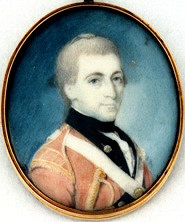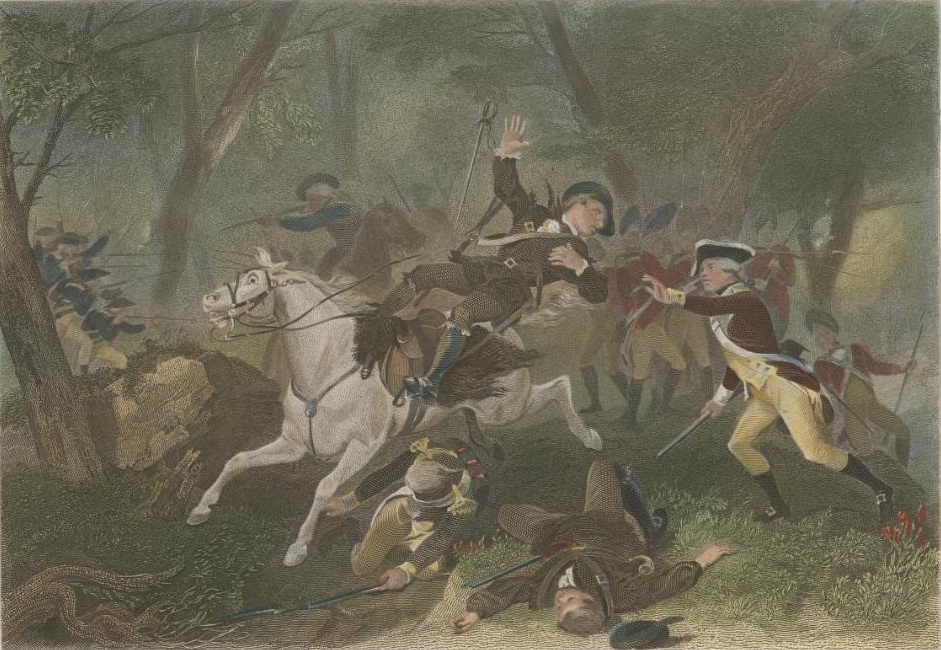Patrick Ferguson

Anonymous miniature of Patrick Ferguson, c. 1774-77
Patrick Ferguson was born on 24 May/4 June 1744. He was the second son of James Ferguson of Pitfour, an Aberdeenshire-born advocate, and his wife Anne Murray, sister of the noted literary patron, Patrick, Lord Elibank. The Fergusons lived mostly in and around Edinburgh — then "a hotbed of genius" according to their acquaintance, the novelist Tobias Smollett — and mixed with the leading figures in the Scottish Enlightenment. Other friends included John Home, David Hume, Adam Ferguson (no relation), Allan Ramsay, & c. Between 1764-76, James Ferguson served on the bench as 'Lord Pitfour', and as a judge was noted for clemency and wit. The Fergusons were a cultured and affectionate family. The three boys and three girls who reached adulthood all had lively and distinctive personalities. The eldest son, Jamie, was MP for Aberdeenshire for 30 years, dying as 'Father of the House of Commons' in 1820, aged 85, while the youngest, George, was, for a time, Lieutenant-Governor of Tobago.
"Pattie," as his family called him, was extremely slender — he often joked about being nothing but bone — and not very tall. But his features were handsome, slightly elfin-looking. His personal letters reveal him as a gentle yet fun-loving young man, with great wit and charm. He was intelligent, sensitive, honourable, and remarkably courageous; flirtatious, too, when he had time! An articulate and expressive writer, it is a singular tragedy that he did not live to write his memoirs.
Ferguson began his career, aged 15, as Cornet in the Royal North British Dragoons (Scots Greys), encouraged by his uncle Gen. James Murray. After training, he was sent to Germany in 1761, where he served in the Seven Years' War, until illness left him with a lame leg, which gave him years of intermittent trouble. He then served with his regiment on garrison duty around Britain. He visited France twice in 1766. In 1768, he bought a Captaincy in the 70th Foot, and spent 3 years in the Caribbean. He returned to Britain in 1772.
A brilliant marksman with innovative ideas on light infantry tactics, he improved Chaumette's breechloading mechanism, already used in sporting guns, for use in a military rifle. The Ferguson Rifle was successfully tested, at his own expense, in 1776. With such a weapon, light infantry troops would be able to continue loading and firing without breaking cover or while lying prone. Appointed Captain Commandant of his own corps, armed with Ferguson rifles, he was sent to North America in spring 1777.
The green-clad rifle company served in New Jersey, before sailing to the Chesapeake in August 1777 to take part in Howe's campaign to capture Philadelphia. They performed well, and Howe, impressed, assured Ferguson that the little corps of 100 men would be increased — but tragedy intervened.
In their only major engagement at Brandywine on 11 September 1777, Ferguson had the chance to shoot a senior-looking Rebel officer, who was riding out with a French hussar as escort, but, as he later wrote, the idea of shooting in the back someone who was going about his duties so coolly, and did not pose a threat, "disgusted" him. Even when told next day that the officer in question was Washington, he did not regret his chivalry. 54 years later, Fenimore Cooper claimed his father-in-law, De Lancey, then serving with Ferguson, had said the officer involved was Pulaski, not Washington, and that the incident happened after Ferguson was maimed, not before — but this is contradicted, nearer the time, by Ferguson himself, and by the extent of his injuries. It is possible that Pulaski may have been the French hussar.
It was moments after sparing these horsemen that Ferguson was gravely wounded — shot through the right elbow-joint. For 8 months, in Philadelphia, he suffered numerous agonising operations to remove bone splinters, under threat of amputation — or death. In letters home, dictated or written left-handed, he joked bravely about his plight and made wisecracks about the surgeons who argued whether his arm should belong to him or "the worms". He kept his arm, but it was permanently crippled. The plans for augmenting his rifle company had to be curtailed. The army gave higher priority to making more of the less expensive, general service weapons, and the corps was disbanded. There is no need to advance any conspiracy theories about this: the corps had been an experiment, and at the time it seemed unlikely that Ferguson would ever be fit for service again. However, he was tougher than he looked. Undeterred, he learned to fence and shoot with his left hand.
By autumn 1778, Ferguson, nicknamed "The Bulldog" for his tenacity, was leading daring raids, such as that against the privateer base, Little Egg Harbor, in NJ. As commander of Stony Point in 1779, he designed improvements to the fortifications. He also wrote proposals to curtail marauding against civilians. He was commissioned Major in the 71st Regt. (Fraser's Highlanders), and at the turn of 1779-80, was posted South in the campaign for the Carolinas.
In March 1780, at MacPherson's Plantation, near Charleston, Ferguson was bayoneted through his good arm in a 'friendly fire' incident involving Charles Cochrane and the British Legion infantry. For 3 weeks he rode with the reins in his mouth, propped up in the saddle by his orderlies. With the capture of Charleston, Gen. Sir Henry Clinton appointed him Inspector of Militia, to recruit and train local Loyalists. He gave up a brevet Lieutenant Colonelcy to do so. Recognising that the war in the South was a civil war, he tried to win people over to the Loyalist cause, visiting their houses and talking to them.
In autumn 1780, Ferguson warned the 'Overmountain' men to desist from rebellion or he would bring fire and sword down upon them, and hang their leaders. The Rebels took up the challenge: to hunt down Ferguson. There was no question of taking him alive. The counter-sign was "Buford" — in revenge for the losses at Waxhaws.
When Ferguson learned of the enemy's advance, he issued an impassioned proclamation to rally the local Loyalists, and began to withdraw towards Cornwallis' base in Charlotte. On 6 October, he encamped on King's Mountain, expecting reinforcements — but some messages were intercepted, and those which reached Cornwallis were not dealt with immediately, because of illness.

Death of Major Ferguson at King's Mountain
This 1863 engraving by Alonzo Chappel was used as an illustration with the above text as a caption.
Note that officially the battle is spelled without an apostrophe.
On 7 October 1780, the Loyalists made their stand when the Rebels surrounded them in a surprise attack at the Battle of kings Mountain. In a desperate struggle, Patrick Ferguson, the only British serviceman in the battle, fought heroically, until he was shot from his horse. His slight body, which had overcome so much pain and disability, was torn by at least 8 bullets. He died within minutes, without regaining consciousness. Rebel fire continued for some time after the white flag was raised. The subsequent abuse of the prisoners, several of whom were hanged and others hacked at with swords on the march up country, brought the Rebels no glory. Ferguson's corpse was brutally treated, and buried under a cairn on the hillside. Legend has it that his girlfriend, Virginia Sal, shot early in the battle, shares his grave.
Reinforcements arrived 3 days too late, and news of their "gentle Pattie"'s death reached his widowed mother and siblings in Scotland shortly before Christmas, 1780.
– Dr. M. M. Gilchrist, St. Andrews, Scotland, 1999.
Further Reading: To date, the best published collection of Ferguson's military writings, with a biographical introduction, is Hugh F. Rankin, "An Officer Out of His Time: Correspondence of Major Patrick Ferguson, 1779-1780", in Howard H. Peckham (ed.) Sources of American Independence, vol. II, Chicago & London, 1978.


